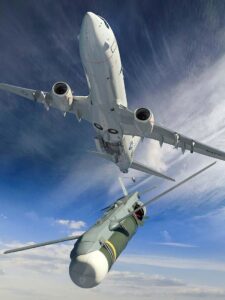Boeing [BA] said on Nov. 22 its High Altitude Anti-Submarine Warfare Weapon Capability (HAAWC) achieved initial operational capability (IOC) status from the Navy.
This weapon allows the Boeing P-8A Poseidon maritime patrol aircraft to deploy Mk 54 torpedoes from near or below the aircraft’s cruising altitude, allowing deployment from higher altitudes and longer distances.

“The initial operational capability milestone marks the readiness of HAAWC for fleet introduction for the Navy and its international partners. We’re excited to deliver greater flexibility and capability by way of higher-altitude launches from longer distances than previously possible,” Dewayne Donley, Boeing program manager, said in a statement.
The IOC notice comes two months after the Navy awarded Boeing a $26 million full-rate production contract for the HAAWC (Defense Daily, Aug. 22).
The HAAWC gives the torpedo a GPS-aided precision glided flight to the water, then it deploys a stabilizer to let the torpedo enter the water. It consists of a modular Air Launch Accessory (ALA) kit that attaches to an Mk 54 torpedo.
More HAAWC units are scheduled to be fielded through 2024 while the current contract includes options that could extend the work through 2030.
“It’s a major achievement for our team in reaching our goal of establishing a new high ground in anti-submarine warfare. We look forward to continuing to work alongside the Navy toward the full deployment and operational capability of the system,” Bob Ciesla, vice president of Boeing Weapons, added.